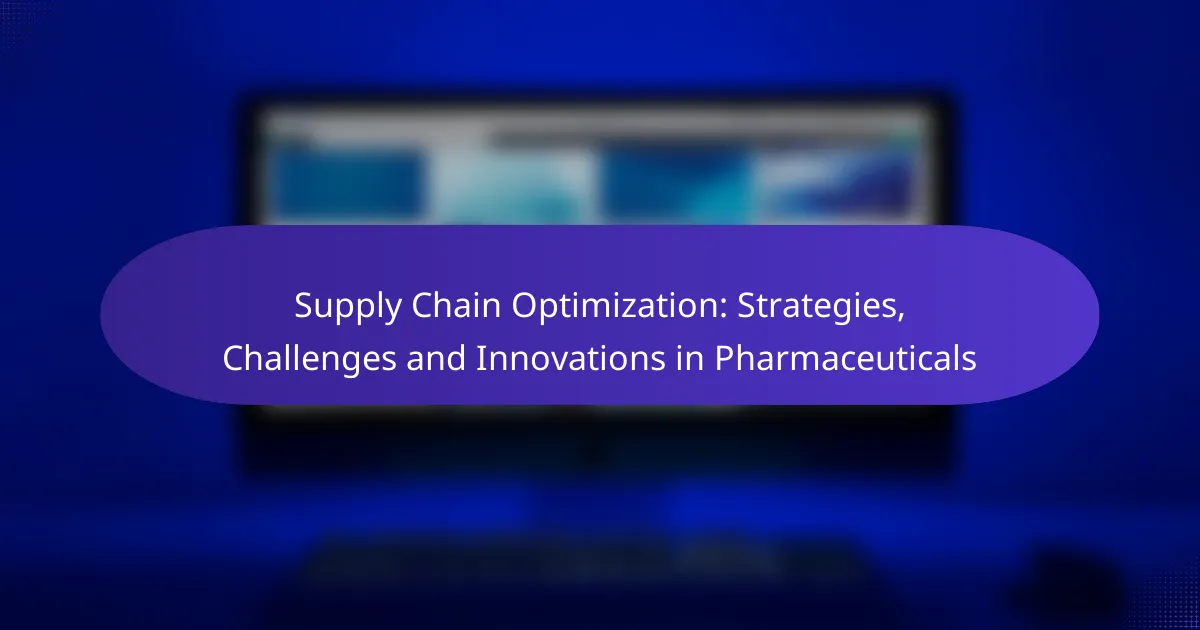Supply chain optimization in the pharmaceutical industry is essential for enhancing efficiency and ensuring timely delivery of high-quality products. Key strategies include lean inventory management, data analytics integration, and technology adoption, which collectively address challenges such as regulatory compliance and demand forecasting inaccuracies. Innovations like blockchain and artificial intelligence further streamline processes, making it crucial for companies to adapt and thrive in a complex and highly regulated environment.

What are the key strategies for supply chain optimization in pharmaceuticals?
Key strategies for supply chain optimization in pharmaceuticals include lean inventory management, data analytics integration, supplier collaboration, technology adoption, and regulatory compliance. These approaches aim to enhance efficiency, reduce costs, and ensure timely delivery of products while maintaining high-quality standards.
Lean inventory management
Lean inventory management focuses on minimizing waste and reducing excess stock in the pharmaceutical supply chain. By adopting just-in-time (JIT) practices, companies can maintain optimal inventory levels, which helps in lowering holding costs and improving cash flow.
Implementing lean principles involves regular assessment of inventory turnover rates and demand forecasting accuracy. For instance, using techniques like Kanban can streamline inventory replenishment processes and ensure that products are available when needed without overstocking.
Data analytics integration
Integrating data analytics into the supply chain allows pharmaceutical companies to make informed decisions based on real-time insights. By analyzing historical data and market trends, organizations can predict demand fluctuations and optimize their inventory accordingly.
Utilizing advanced analytics tools can help identify inefficiencies and bottlenecks in the supply chain. For example, predictive analytics can forecast potential disruptions, enabling proactive measures to mitigate risks and enhance overall supply chain resilience.
Supplier collaboration
Effective supplier collaboration is crucial for optimizing the pharmaceutical supply chain. Building strong relationships with suppliers fosters transparency and communication, which can lead to better alignment on production schedules and inventory management.
Regular meetings and joint planning sessions can help address challenges and identify opportunities for improvement. Establishing performance metrics and sharing data can further enhance collaboration, ensuring that all parties are working towards common goals.
Technology adoption
Adopting technology is essential for streamlining supply chain operations in the pharmaceutical industry. Tools such as Enterprise Resource Planning (ERP) systems and supply chain management software can automate processes, improve data accuracy, and enhance visibility across the supply chain.
Investing in technologies like blockchain can also increase traceability and security, which are vital in pharmaceuticals. For example, blockchain can help track the provenance of drugs, ensuring compliance with regulations and reducing the risk of counterfeit products.
Regulatory compliance
Regulatory compliance is a critical aspect of supply chain optimization in pharmaceuticals. Companies must adhere to strict guidelines set by authorities such as the FDA or EMA to ensure product safety and efficacy.
Staying compliant involves regular audits, documentation, and training for staff on current regulations. Implementing a robust compliance management system can help streamline these processes and reduce the risk of non-compliance, which can lead to costly penalties and reputational damage.

What challenges do pharmaceutical companies face in supply chain optimization?
Pharmaceutical companies encounter several significant challenges in supply chain optimization, including regulatory hurdles, supply chain disruptions, cost management issues, data silos, and inaccuracies in demand forecasting. Addressing these challenges is crucial for ensuring efficiency, compliance, and overall success in the highly regulated pharmaceutical industry.
Regulatory hurdles
Pharmaceutical companies must navigate a complex landscape of regulations that vary by country and region. Compliance with standards set by organizations such as the FDA in the United States or EMA in Europe can slow down processes and increase costs. Companies must invest in robust compliance systems to avoid penalties and ensure product safety.
To manage regulatory hurdles effectively, companies should maintain up-to-date knowledge of relevant regulations and engage in proactive communication with regulatory bodies. Regular audits and training for staff can also help mitigate risks associated with non-compliance.
Supply chain disruptions
Supply chain disruptions can arise from various factors, including natural disasters, geopolitical tensions, and pandemics. These disruptions can lead to delays in production and distribution, impacting the availability of critical medications. Companies need to develop contingency plans to address potential disruptions and ensure continuity of supply.
Implementing a diversified supplier strategy can reduce reliance on a single source and enhance resilience. Additionally, investing in technology for real-time monitoring can help identify issues early and facilitate quicker responses.
Cost management issues
Cost management is a persistent challenge in the pharmaceutical supply chain, driven by rising raw material costs, labor expenses, and the need for advanced technologies. Companies must balance cost reduction with maintaining quality and compliance, which can be a difficult trade-off.
To optimize costs, companies should analyze their supply chain processes for inefficiencies and consider adopting lean manufacturing principles. Regularly reviewing supplier contracts and exploring alternative sourcing options can also lead to significant savings.
Data silos
Data silos occur when information is isolated within different departments or systems, hindering collaboration and decision-making. In the pharmaceutical industry, this can lead to inefficiencies and missed opportunities for optimization. Breaking down these silos is essential for a cohesive supply chain strategy.
Implementing integrated software solutions that facilitate data sharing across departments can enhance visibility and streamline operations. Regular cross-departmental meetings can also foster collaboration and ensure that all teams are aligned on supply chain goals.
Demand forecasting inaccuracies
Inaccurate demand forecasting can result in either excess inventory or stockouts, both of which are detrimental to pharmaceutical companies. Factors such as market trends, seasonality, and unexpected health crises can complicate accurate predictions. Companies must adopt more sophisticated forecasting methods to improve accuracy.
Utilizing advanced analytics and machine learning can enhance forecasting capabilities by analyzing historical data and identifying patterns. Collaborating with sales and marketing teams can also provide valuable insights into upcoming demand changes, leading to more informed decisions.

How can technology improve pharmaceutical supply chains?
Technology enhances pharmaceutical supply chains by increasing efficiency, accuracy, and visibility. Key innovations such as blockchain, artificial intelligence, the Internet of Things, and cloud computing streamline processes and improve decision-making.
Blockchain for traceability
Blockchain technology provides a secure and transparent way to track pharmaceutical products throughout the supply chain. By creating a decentralized ledger, stakeholders can verify the authenticity and origin of medications, reducing the risk of counterfeit drugs.
Implementing blockchain requires collaboration among manufacturers, distributors, and regulators. Companies should consider integrating blockchain solutions that comply with local regulations, such as the Drug Supply Chain Security Act (DSCSA) in the United States.
AI for demand forecasting
Artificial intelligence (AI) improves demand forecasting by analyzing historical data and market trends to predict future needs. This technology helps pharmaceutical companies optimize inventory levels, reducing excess stock and minimizing shortages.
To effectively leverage AI, companies should invest in robust data analytics platforms and ensure data quality. Regularly updating algorithms based on real-time sales data can enhance accuracy, leading to better alignment with market demands.
IoT for real-time monitoring
The Internet of Things (IoT) enables real-time monitoring of pharmaceutical products during transit and storage. Sensors can track temperature, humidity, and location, ensuring that products remain within required conditions to maintain efficacy.
Implementing IoT solutions involves selecting appropriate sensors and integrating them with existing supply chain management systems. Companies should also establish protocols for responding to alerts, such as deviations from set parameters, to mitigate risks.
Cloud computing for data sharing
Cloud computing facilitates seamless data sharing among stakeholders in the pharmaceutical supply chain. By utilizing cloud-based platforms, companies can access and share critical information in real-time, improving collaboration and decision-making.
When adopting cloud solutions, organizations should prioritize security and compliance with data protection regulations, such as the General Data Protection Regulation (GDPR) in Europe. Regular audits and updates to cloud systems can help maintain data integrity and security.

What role does data analytics play in supply chain optimization?
Data analytics is crucial for enhancing supply chain optimization by providing insights that drive decision-making and efficiency. It enables pharmaceutical companies to forecast demand, manage inventory levels, and streamline operations, ultimately reducing costs and improving service levels.
Predictive analytics for inventory
Predictive analytics uses historical data and statistical algorithms to forecast future inventory needs. In pharmaceuticals, this means anticipating demand fluctuations based on factors like seasonality, market trends, and patient needs. By leveraging predictive models, companies can maintain optimal stock levels, minimizing both overstock and stockouts.
For effective implementation, companies should regularly update their models with new data and consider external variables such as regulatory changes or emerging health trends. Tools like machine learning can enhance accuracy, allowing for more responsive inventory management.
Performance metrics tracking
Tracking performance metrics is essential for evaluating the effectiveness of supply chain operations. Key performance indicators (KPIs) such as order fulfillment rates, lead times, and inventory turnover provide insights into operational efficiency. In the pharmaceutical sector, maintaining high standards is critical due to regulatory requirements and the need for timely delivery of products.
Companies should establish a dashboard to monitor these metrics in real-time, enabling quick adjustments to processes as needed. Regular reviews of these metrics can help identify areas for improvement and drive continuous optimization efforts.
Risk assessment models
Risk assessment models help identify potential disruptions in the supply chain and evaluate their impact. In pharmaceuticals, risks can stem from various sources, including supplier reliability, regulatory changes, and market volatility. By analyzing these risks, companies can develop strategies to mitigate them, ensuring a more resilient supply chain.
Implementing a risk assessment framework involves categorizing risks, assessing their likelihood and potential impact, and developing contingency plans. Regularly updating these assessments in response to changing conditions is crucial for maintaining supply chain integrity.

How do pharmaceutical companies ensure regulatory compliance in supply chains?
Pharmaceutical companies ensure regulatory compliance in their supply chains through a combination of regular audits, thorough documentation, and adherence to established standards. These practices help maintain product quality and safety while meeting legal requirements.
Regular audits and assessments
Regular audits and assessments are critical for maintaining compliance in pharmaceutical supply chains. Companies typically conduct internal audits at least annually, while external audits may occur more frequently, depending on regulatory requirements or supplier risk levels.
During these audits, companies evaluate processes, supplier performance, and adherence to Good Manufacturing Practices (GMP). This proactive approach helps identify potential issues before they escalate, ensuring that corrective actions can be taken promptly.
Documentation and reporting
Thorough documentation and reporting are essential for demonstrating compliance in pharmaceutical supply chains. Companies must maintain detailed records of manufacturing processes, quality control measures, and supplier qualifications to provide transparency and accountability.
Regular reporting to regulatory bodies, such as the FDA in the United States or EMA in Europe, is also necessary. This includes submitting data on product quality, safety incidents, and any changes in manufacturing processes, which helps to ensure ongoing compliance and build trust with regulators.



